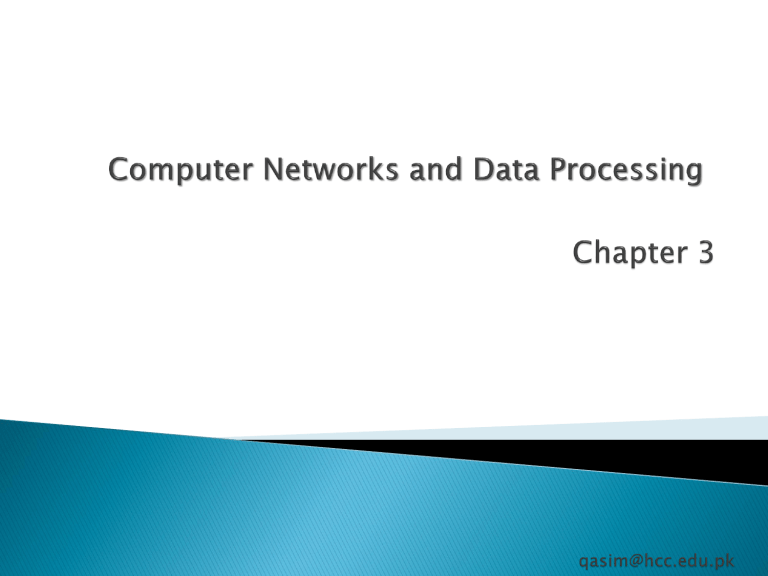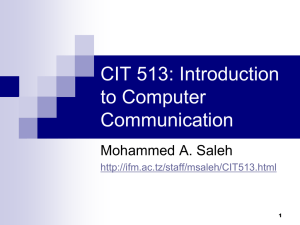Chapter03-1 |

A computer network, often simply referred to as network, is a collection of computers and devices connected by communications channels that facilitates, communications among users and allows users to share resources with other users .
File Sharing
Text Communication
Voice Communication
Password Protected Directories
Secure Data Access
Resources Sharing such as
◦ scanners, fax machines and printers etc.
A path through which data is transmitted from one place to another place is called transmission media or channel.
◦
Wired / Guided Medium
In this medium devices are directly connected with each other using physical media like wires. Such as:
Twisted pair cable, Coaxial Cable, Optical Fiber Cable
◦
Wireless / Unguided Medium
In this medium devices are directly connected with each other through air using signals/waves Examples:
Communications Satellites
Cellular Systems
Wireless LANs,
Bluetooth
All networks are made up of basic hardware building blocks to interconnect network nodes, such as:
◦
NICs Cards
◦
Bridges
◦
Hubs
◦
Switches
◦
Routers
◦
Repeaters
◦ .…………
Every computer is directly connected with the hub.
When data packets arrives at hub, it broadcast them to all the LAN cards in a network and the destined recipient picks them and all other computers discard the data packets.
Hub has five, eight, sixteen and more ports and one port is known as uplink port, which is used to connect with the next hub.
When two or more computers try to send the data signals at the same time, a collision occurs and the process is known as
Collision Detection..
In the data communications, a hub is a place for the convergence where data arrives from multiple directions and forward to the multiple directions. The most advanced form of the hub is the intelligent or smart hub that contains the management software which is used to troubleshoot the most common problems.
Bridges are the networking devices that divided up the network into different segments to reduce the amount of traffic on each network.
A bridge blocks and forwards the data packets based on their MAC(
a Media Access
Control address (MAC address) is a unique identifier assigned to most network adapters or network interface cards (NICs) by the manufacturer for identification
) addressees.
A network switch is a LAN/WAN communication device. It joins the multiple computers together in the LAN and WAN.
In the LAN, the switches do not broadcast the data to all the connected computers like the hub.
A switch conserves the bandwidth and offers the grater performance than the hub.
physically (wired) different networks.
On the internet, the routers plays the functions of
computer.
A router is used to connect the two LANs, two network.
A network router joins two computer networks together. DSL and cable modem routers are
MODEMS
A modem is a communication device that is used to provide the connectivity with the internet. Modem works in two ways i.e. modulation and demodulation. It coverts the digital data into the analog and analog to digital
LAN CARDS
LAN cards or network adapters are the building blocks of a computer network. No computer can communicate without a properly installed and configured LAN card.
A repeater is an electronic device that receives a signal and retransmits it at a higher level and/or higher power, or onto the other side of an obstruction, so that the signal can cover longer distances.
It's a device usually used to extend wireless coverage in wireless network by repeating the wireless signal generated by wireless router/access point. Some better repeaters also able to improve wireless transmission rate. This device is also referred as wireless range extender, booster or expander by some vendors.
In computer terms a firewall is a system
(either hardware based or software based) that divide, actually isolate the two fields, one being the external world ie. the Internet, and the other, the internal world or computer or computer network.
Controlling the packets of data that goes through a firewall, allows to block potential hackers to infiltrate your network and also to control in both directions the use of the internet connection.
Opening a number of ports in the firewall, we can allow information to go from the internet to our network (inbound traffic) or from our computer or network outside
(outbound traffic).
Coaxial Cable - Cable consisting of a single copper conductor in the center surrounded by a plastic layer for insulation and a braided metal outer shield.
Fiber Optic Cable - A cable, consisting of a center glass core surrounded by layers of plastic, that transmits data using light rather than electricity. It has the ability to carry more information over much longer distances.
Twisted Pair - Network cabling that consists of four pairs of wires that are manufactured with the wires twisted to certain specifications. Available in shielded and unshielded versions.
Terminator - A device that provides electrical resistance at the end of a transmission line. Its function is to absorb signals on the line, thereby keeping them from bouncing back and being received again by the network.
Token - A special packet that contains data and acts as a messenger or carrier between each computer and device on a ring topology. Each computer must wait for the messenger to stop at its node before it can send data over the network.
Token Ring - A network protocol developed by IBM in which computers access the network through token-passing.
Backbone - A cable to which multiple nodes or workstations are attached.
Connector - Standard connectors used to connect coaxial/Fiber Optic / Twisted Pair cables.
Full-Duplex: Data flows in both directions simultaneously. Modems are configured to flow data in both
Directions.
Example : Mobiles,ComputerNetworks
.
U
T
E
R
C
O
M
P
O
R
K
S
N
E
T
W
Local-Area Network
(LAN)
Campus-Area Network
(CAN)
Personal-Area Network
(PAN)
Metropolitan-Area Network
(MAN)
Wide-Area Network
(WAN)
A LAN (Local Area Network) is a group of computers and network devices connected together, usually within the same building.
Data rates are much higher with low error rates. LANs are designed to share resources between personal computers or work stations. LANs are distinguished by their
Sizes, Transmission Media (by twisted-pair wire , coaxial cables , or fiber optic cables),
Topology (Bus, star, Ring, mesh etc.)
.
Networking spanning with multiple LANs but smaller than a Metropolitan area network,
MAN.
This kind of network mostly used in relatively large universities or local business offices and buildings.
A personal area network - PAN - is a computer network organized around an individual person. Personal area networks typically involve a mobile computer, a cell phone and/or a handheld computing device such as a
PDA. You can use these networks to transfer files including email and calendar appointments, digital photos and music.
Personal area networks can be constructed with cables or wirelessly. USB /WI-FI(
Ptcl,wi-tribe, ufone, warid, wateen.) , Broad
Band (Ptcl, World Call, Wateen) technologies often link together a wired
PAN. While wireless PANs typically use
Bluetooth or sometimes infrared connections. Bluetooth PANs are also called piconets. Personal area networks generally cover a range of less than 10 meters.
A WLAN, local area network based on wireless network technology mostly referred as Wi-Fi, Wi-Max. Unlike LAN, in WLAN no wires are used, but radio signals are the medium for communication.
Wireless network cards are required to be installed in the systems for accessing any wireless network around. Mostly wireless cards connect to wireless routers for communication among computers or accessing WAN, internet.
MAN consists of a medium size geographical area. The scope of the MAN is always a city
,town or any two or three near by cities.
Common example is Cable TV Network. A company can use a MAN to connect to all of its offices/branches throughout a city.
A wide area network (WAN) is a computer network that covers a broad area (i.e., any network whose communications links cross metropolitan, regional, or national boundaries). This is in contrast with personal area networks (PANs), local area networks (LANs), campus area networks
(CANs), or metropolitan area networks
(MANs) which are usually limited to a room, building, campus or specific metropolitan area (e.g., a city) respectively.
This is
the world-wide network
of computers accessible to anyone who knows their
Internet Protocol (IP) address. The IP address is a unique set of numbers (such as
207.46.222.30) that defines the computer's location. Most will have accessed a computer using a name such as http://www.hailey.tech.officelive.com
.
Before this
named
computer can be accessed, the name needs to be resolved (translated) into an IP address. To do this your browser
(for example Netscape or Internet Explorer) will access a Domain Name Server (DNS) computer to lookup the name and return an
IP address - or issue an error message to indicate that the name was not found.
Once your browser has the IP address it can access the remote computer. The actual server (the computer that serves up the web pages) does not reside behind a firewall - if it did, it would be an Extranet. It may implement security at a directory level so that access is via a username and password, but otherwise all the information is accessible.
This is a network that is not available to the world outside of the Intranet. If the network is connected to the
Internet
Intranet
, the
Intranet will reside behind a firewall and, if it allows access from the Internet, will be an
Extranet. The firewall helps to control access between the Intranet and Internet to permit access to the Intranet only to people who are members of the same company or organization.
An Extranet is actually an Intranet that is partially accessible to authorized outsiders.
The actual server (the computer that serves up the web pages) will reside behind a firewall.
The firewall helps to control access between the
Intranet and Internet permitting access to the
Intranet only to people who are suitably authorized.
The level of access can be set to different levels for individuals or groups of outside users.
The access can be based on a username and password or an IP address (a unique set of numbers such as 209.33.27.100 that defines the computer that the user is on).
Topology refers to the physical or logical arrangement of a network. A network topology is how computers, printers, and other devices are connected over a network.
For example, devices can be arranged in a ring or in a straight line (bus topology) or
Mesh or Star.
In a mesh topology, every device has a dedicated point to point link to every other device.
To connect n devices, we require n(n-1)/2 physical links .Example: (5 Pc’s) 5(5-1)/2=10 wires .
Advantage & Disadvantages
The use dedicated links guarantees that each connection can carry its own data load. It provides privacy and security. The mesh topology is robust.
The main disadvantage is related to the amount of cabling and the number of Input/output ports required (For example a pc required more than one
Lan Card (Ethernet Card)).
In a star topology, each device has a dedicated point to point link only to a central controller.
A star topology is designed with each node (file server, workstations, and peripherals) connected directly to a central network hub or switch .
Data on a star network passes through the hub or switch before continuing to its destination.
The hub or switch manages and controls all functions of the network.
It also acts as a repeater for the data flow. This configuration is common with twisted pair cable ; however, it can also be used with coaxial cable or fiber optic cable .
Advantages & Disadvantages:
◦ A star topology is less expensive than mesh topology.
◦ Each device needs only one link and one
Input/output port to connect with other device.
◦ The star topology is robust.
◦ Entire network shuts down if there is a break in the hub/switch.
A bus topology is a multipoint topology in which one long cable acts as a backbone to link all the devices in the network.
If you need help remembering how the Bus
Topology operates, think of it as the route a bus takes throughout a city.
It is extremely important to note that both ends of the main cable need to be terminated.
If there is no terminator, the signal will bounce back when it reaches the end.
The result: a bunch of collisions and noise that will disrupt the entire network. A network hardware device tap is a which provides a way to access the data flowing across a computer network.
Advantages & Disadvantages
◦ Easy to connect a computer to a bus topology .
◦ Requires less cable length than a star topology
◦ Ease of installation.
◦ Uses less cabling than mesh or a star.
◦ Entire network shuts down if there is a break in the main cable.
◦ Terminators are required at both ends of the backbone cable.
◦ Difficult to identify the problem if the entire network shuts down
Topology, no terminators are necessary. circle, stopping at each node
Advantages & Disadvantages:
Easy to install and reconfigure.
Unidirectional traffic can be disadvantages.
Entire network shuts down if there is a break in the main cable
The five main components of data communication system are:
1. Message - It is the information to be communicated. Popular forms of information include text, pictures, audio, video etc.
2. Sender - It is the device which sends the data messages. It can be a computer, workstation, telephone handset etc.
3. Receiver - It is the device which receives the data messages. It can be a computer, workstation, telephone handset etc.
4. Transmission Medium - It is the physical path by which a message travels from sender to receiver. Some examples include twisted-pair wire, coaxial cable, radiowaves etc.
5. Protocol - It is a set of rules that governs the data communications.
It represents an agreement between the communicating devices.
Without a protocol, two devices may be connected but not communicating.
The transmitter(sender) sends the message and the receiver receives the message. The medium (guided, unguided) is the channel over which the message is sent and the protocol (for example IP, DHCP etc) is the set of rules that guides how the data is transmitted. The message of course is central to all the other components. The message is the data that is being communicated.
Q. DATA PROCESSING CYCLE
1. Origination (Preparation)
The initial capture of raw data on documents as transactions occur is referred to as origination. This could be in the form of various documents such as: receipts, time cards, deposit slips, sales orders, enrollment forms, tickets, to name just a few of the examples
Feedback
2. Input
Source documents are collected and converted into some convenient form for processing. When editing input data, you should identify and arrange data with like characteristics into groups or classes. For example, enrollment forms may be classified according to year level, courses, and the like.
3. Processing
The input data is manipulated to produce data give useful information.
This is the actual operation performed on the input data. This operation includes classifying, sorting, calculating, recording, and summarizing data.
4. [Output ]or [Storage]
This step yields the results of the data processing in an appropriate form accepted to the user for analysis or as an input for a second cycle.
Again communication is important in output preparation and dissemination. Failure to communicate the output clearly, completely, and accurately to the user is an waste of time and effort.
5. Feedback
Feedback is required for correction of errors from end users (who use data).
For instance, if you are using a spreadsheet application such as Excel,
The sales clerk inputs the sales made for the day in to a spreadsheet.
At the end of the day, just before the close of work, the total sales for that day are added together, in other words the sales data is processed and the result (the output) is printed and sent to the sales manager.
The printed sales report which is being sent to the sales manager is referred to as information.
Three basic stages of data process are illustrated below:
Daily sales invoice is collected and inputted into the computer(data)
All sales are added together (process)
The total sale is printed out (output)
For data processing to occur electronically, four hardware components are necessary input devices, a central
processing unit, output devices and media for secondary storage.
The stage of data collection and input varies with the application used. However, this stage may include the following:
• Preparation of the source document
• Data coding and verification
• Data validation Data storage
9
10
5
6
7
8
3
4
1
2
-
-
-
-
-
-
-
-
-
-
This is a computer-controlled stage in which the data is processed after input. For example the sales transaction for the day is
totaled and transferred from the sales daybook to the sales
ledger, using the excel software package. This data processing stage also involves storage and retrieval.
At this stage, the data that has been processed and is now in a
useful form. That is, when that has been processed, it becomes information . The output (using the above example) will be the
summary transaction for the day. This will be displayed in the
Excel worksheet and can now be printed for management use. As said earlier it can also be saved and stored in an electronic format for future use.
Depend on your business requirements you can choose several data processing services as follows:
Forms processing
Check processing
Survey processing
Credit card processing
Transaction processing
Word processing
Order processing
Insurance claims processing
Market research processing
Back office operation
Other data processing services.
Speed
Accuracy
Number of transactions
Cost
Selectivity (Different Views of same data)
Information
Record Keeping
Customer Service and Support











